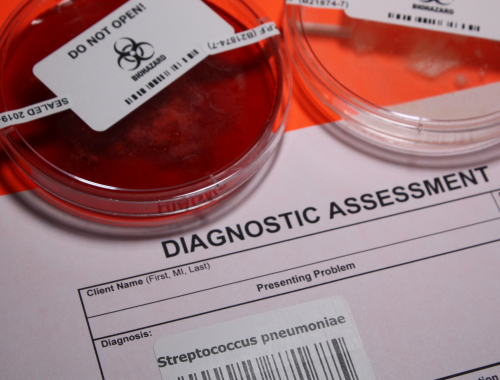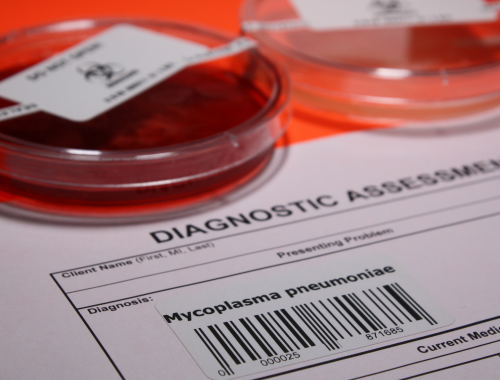Difference Between Streptococcus Pneumoniae and Mycoplasma Pneumoniae
Streptococcus pneumoniae or pneumococcus is a gram-positive, alpha-hemolytic member of the streptococcal genus. It is one of the most common causes of pneumonia in humans. Mycoplasma pneumoniae is a very small bacterium, which lacks a cell wall and infects the airways. It is a common cause of atypical bacterial pneumonia in humans.

What is Streptococcus pneumoniae?
Definition:
Streptococcus pneumoniae or pneumococcus is a gram-positive, encapsulated bacterium that is an alpha-hemolytic member of the streptococcal genus. It is one of the commonest cause of community-acquired pneumonia. Pneumococcus also commonly causes sinusitis, otitis media, and meningitis.
Epidemiology:
Streptococcus pneumoniae readily infects children and young adults. It is the most common cause of otitis media in children and pneumonia and meningitis in adults. Conditions that cause immune suppression like HIV infection, tumor, or diabetes mellitus increase the propensity to get a pneumococcal infection.
Symptoms:
S. pneumoniae infection presents with a variety of symptoms depending on the organ or site affected. Pneumococcal pneumonia typically presents as a high-grade fever, cough with sputum, shortness of breath, pleuritic chest pain, and lethargy. Otitis media due to S. pneumoniae presents with intense ear pain, discharge, and difficulty in hearing. Pneumococcal meningitis is common in children and adolescents. It presents neck rigidity, fever, and altered mental status.
Diagnosis:
Gram staining and culture are important tests for detecting S. pneumoniae. Blood, cerebrospinal fluid, lung aspirate, pus, and sputum are important specimens for culture testing. Important blood tests include complete blood count, erythrocyte sedimentation rate, and C- reactive protein. Imaging tests such as chest X-ray and Computed tomography (CT) of the chest are important for detecting pneumonia.
Treatment:
Penicillin (such as ampicillin and amoxicillin) is the drug of choice for pneumococcal infections. In case of resistance to penicillin, drugs such as ceftriaxone, cefotaxime, fluoroquinolones (such as levofloxacin), and vancomycin are used to treat the infection. Pneumococcal meningitis is treated with ceftriaxone or cefotaxime.

What is mycoplasma pneumoniae?
Definition:
Mycoplasma pneumoniae is a small bacterium that readily infects the airways. It is a leading cause of atypical pneumonia in humans. It lacks a cell wall and is unidentifiable on gram staining.
Epidemiology:
10% of mycoplasma pneumoniae infections end up as atypical pneumonia. People who are at an increased risk of developing mycoplasma infection include immunocompromised individuals such as HIV patients, diabetics, and those on steroid therapy, and chemotherapy. Children less than 5 years old, and people with lung disease and sickle cell disease are more at risk of developing atypical mycoplasma pneumonia.
Symptoms:
Typical features of pneumonia such as high fever and productive cough are not seen in mycoplasma pneumonia. Symptoms of mycoplasma pneumonia are a low-grade fever, dry cough, and fatigue.
Diagnosis:
Bronchial breath sounds on auscultation are appreciated in atypical pneumonia. Chest X-ray is key to detecting the location of pneumonia.
Treatment:
Macrolides (erythromycin, clarithromycin, and azithromycin) are the first line of drugs against mycoplasma infection. Additionally, tetracycline, doxycycline, and quinolones are also prescribed if the infection does not subside with macrolides.
Difference between Streptococcus pneumoniae and Mycoplasma pneumoniae
Definition:
Streptococcus pneumoniae or pneumococcus is a gram-positive, encapsulated bacterium that is an alpha-hemolytic member of the streptococcal genus. It is one of the main cause of community-acquired pneumonia. Mycoplasma pneumoniae is a small bacterium that readily infects the airways. It is a leading cause of atypical pneumonia in humans. It lacks a cell wall and is unidentifiable on gram staining.
Epidemiology:
Streptococcus pneumoniae readily infects children and young adults. It is the most common cause of otitis media in children and pneumonia and meningitis in adults. Conditions that cause immune suppression like HIV infection, tumor, or diabetes mellitus increase the propensity to get a pneumococcal infection. People who are at an increased risk of developing mycoplasma infection include immunocompromised individuals such as HIV patients, diabetics, and those on steroid therapy, and chemotherapy. Children less than 5 years old, and people with lung disease and sickle cell disease are more at risk of developing atypical mycoplasma pneumonia.
Symptoms:
Pneumococcal pneumonia typically presents as a high-grade fever, cough with sputum, shortness of breath, pleuritic chest pain, and lethargy. Symptoms of mycoplasma pneumonia are a low-grade fever, dry cough, and fatigue.
Diagnosis:
Gram staining and culture are important tests for detecting S. pneumoniae. Blood, cerebrospinal fluid, lung aspirate, pus, and sputum are important specimens for culture testing. Imaging tests such as chest X-ray and Computed tomography (CT) of the chest are important for detecting both typical and atypical pneumonia.
Treatment:
Penicillin (such as ampicillin and amoxicillin) is the drug of choice for pneumococcal infections. In case of resistance to penicillin, drugs such as ceftriaxone, cefotaxime, fluoroquinolones (such as levofloxacin), and vancomycin are used to treat the infection. Pneumococcal meningitis is treated with ceftriaxone or cefotaxime. Macrolides (erythromycin, clarithromycin, and azithromycin) are the first line of drugs against mycoplasma infection. Additionally, tetracycline, doxycycline, and quinolones are also prescribed if the infection does not subside with macrolides.
Table of difference between Streptococcus pneumoniae and Mycoplasma pneumoniae

FAQs
What is the difference between Streptococcus pneumoniae and pneumococcal pneumonia?
Pneumococcus is the other name for Streptococcus pneumoniae. Streptococcus pneumoniae is the bacterium that causes pneumococcal pneumonia.
How does Mycoplasma pneumoniae differ from other bacteria?
M. pneumoniae differs from other bacteria as it lacks a cell wall and is very minute sized therefore it is undetectable on traditional gram staining and light microscopy.
What are the distinguishing characteristics of Mycoplasma pneumoniae?
A mycoplasma pneumoniae infection of the lungs has distinct characteristics. Atypical pneumonia presents a low-grade fever, a dry cough, and malaise.
How can you tell the difference between Streptococcus pneumoniae and Mycoplasma pneumoniae?
Streptococcus pneumoniae presents with severe respiratory symptoms such as high-grade fever, productive cough, and malaise whereas Mycoplasma pneumonia causes atypical pneumonia which presents as a dry cough and low-grade fever. Also S. pneumoniae is gram-positive whereas mycoplasma is undetected on gram staining.
What makes Streptococcus pneumoniae unique?
Streptococcus pneumoniae affects a multitude of organs; this makes it unique.
How will you differentiate bacteria and Mycoplasma?
M. pneumoniae differs from other bacteria as it lacks a cell wall and is very minute-sized.
- Differences Between Reptiles and Amphibians - May 17, 2024
- Difference Between Ophthalmology and Optometry - May 15, 2024
- Difference Between Fear and Anxiety - April 2, 2024
Search DifferenceBetween.net :
Leave a Response
References :
[0]Catterall, J. R. "Streptococcus pneumoniae." Thorax 54.10 (1999): 929-937.
[1]Weiser, Jeffrey N., Daniela M. Ferreira, and James C. Paton. "Streptococcus pneumoniae: transmission, colonization and invasion." Nature Reviews Microbiology 16.6 (2018): 355-367.
[2]Mansel, J. Keith, et al. "Mycoplasma pneumoniae pneumonia." Chest 95.3 (1989): 639-646.
